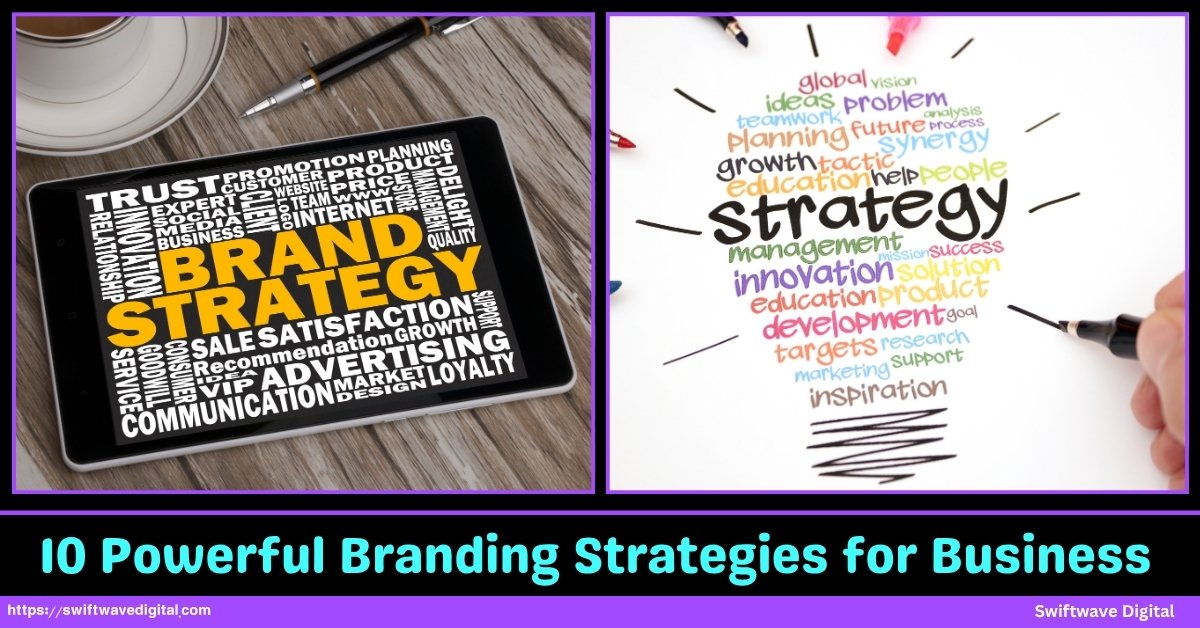Branding Strategies are the foundation of how businesses build recognition, trust, and long-term customer loyalty. In today’s competitive market, where countless brands fight for attention, effective branding isn’t just a marketing exercise it’s a survival strategy.
A strong brand defines how people perceive your business, what they believe about your products, and whether they choose you over someone else.
The truth is, even if your product is superior, without a clear and consistent brand identity, you’ll struggle to stand out or grow sustainably.
Modern consumers don’t just buy products; they buy experiences and values. That’s why businesses from startups to large corporations — are now investing more time and data-driven effort into refining their branding approach.
Whether it’s defining your positioning, crafting your visual identity, or using customer feedback to shape perception, every touchpoint matters.
10 Powerful Branding Strategies for Business
In this guide, we will explain 10 powerful branding strategies that can help your business build authority, connect deeply with customers, and scale with confidence.
1. Define & Own a Clear Brand Positioning
Brand positioning is the foundation of your entire brand strategy. It defines how your brand is perceived in the minds of your target audience and how it stands apart from competitors.
Without a clear position, your brand message will feel scattered and inconsistent. To establish a solid brand position, start by identifying your target market who exactly you serve, what they value most, and what problems they need solved.
Then, research your competitors to find where they stand and identify the gap your business can fill.
Next, define your brand promise a short statement that captures what makes you unique and what customers can expect when they engage with your brand. Keep it simple, factual, and measurable.
Avoid vague adjectives like “best” or “innovative.” Instead, state clear value propositions such as “fastest delivery,” “most affordable solution,” or “eco-friendly material.”
Finally, ensure that all marketing, communication, and design efforts reinforce this position consistently. Repetition builds recognition, and recognition builds trust — the ultimate goal of positioning.
2. Build Visual Identity & Signature Elements (Logo, Color, Typography)
A strong visual identity helps customers recognize your brand instantly across multiple touchpoints. This includes your logo, color palette, typography, and design system. Each element should be chosen strategically to reflect your brand’s purpose and tone.
Your logo should be simple, scalable, and adaptable to both print and digital formats. It must look clean on everything from billboards to mobile screens.
Your color palette should be limited to a few core colors that represent your values — for example, blue often conveys trust, red signals energy, and green reflects sustainability.
Stick to these colors consistently to strengthen visual memory. Typography is equally critical; select fonts that match your brand voice — modern, classic, bold, or minimal and use them consistently in all communications.
Visual consistency increases recognition and signals professionalism. Research shows consistent branding across platforms can increase revenue by up to 20%.
Document these elements in a style guide to ensure everyone in your organization follows the same visual rules. This keeps your brand uniform and recognizable across all marketing materials.
3. Use Storytelling & Brand Narrative
People remember stories, not slogans. Storytelling transforms your brand from a business into something people can relate to emotionally. A powerful brand narrative explains why you exist, what problem you solve, and what impact you create.
Start by sharing your origin — how the brand began, what challenges inspired it, and what purpose drives it forward. Make sure the story aligns with your brand positioning; authenticity is key.
Avoid exaggeration or dramatic language; stick to facts and relatable experiences. You can also highlight customer stories that demonstrate the real-world benefits of your product or service.
Structure your narrative around three parts: the challenge, the solution, and the result. The challenge shows the problem you recognized, the solution highlights what you offer, and the result shows tangible outcomes.
A strong narrative makes people care about your brand beyond price or product features. It helps customers connect emotionally, which builds loyalty and long-term engagement.
4. Create Brand Experience & Touchpoint Consistency
A brand is experienced through every interaction a customer has — website, packaging, ads, emails, support calls, and even after-sales service.
Brand experience means ensuring each touchpoint delivers the same level of quality, tone, and message. Start by mapping your customer journey from the first impression to post-purchase interaction.
Identify all points where customers engage with your brand. Then, ensure each of these reflects your brand’s identity and standards. For example, if your brand stands for reliability, your customer service must be responsive and your website must function smoothly.
If your positioning focuses on luxury, packaging should feel premium, and tone should be refined. Internal communication matters too; your employees must understand your brand values and express them in how they interact with customers.
Consistency builds trust and credibility, while inconsistency confuses customers and weakens perception. Every email, social media post, and product delivery is part of your brand experience keep them aligned to build long-term loyalty.
5. Leverage Personal Branding and Leadership Visibility
In the digital era, people trust people more than faceless corporations. Personal branding of founders, CEOs, or leadership teams can strengthen your business brand significantly.
When leaders speak, share insights, or engage on social media, they put a human face to the company. This increases transparency, credibility, and emotional connection.
Start by defining what your leadership voice should represent expertise, innovation, reliability, or community-driven values. Then, consistently communicate through platforms where your audience is active, such as LinkedIn, YouTube, or podcasts.
Share lessons, opinions, behind-the-scenes experiences, and authentic thoughts that align with your company’s mission. Encourage employees to become brand advocates by sharing brand-aligned content and insights from their perspective.
Personal branding doesn’t replace corporate branding; it reinforces it by making it relatable. Consumers often follow leaders first, then trust the brand they represent.
This approach also helps in attracting talent, building partnerships, and earning media visibility organically.
6. Implement Content Strategy & Thought Leadership
Content strategy is how you position your brand as an authority in your field. It’s not about posting frequently but posting with purpose. Develop a content plan that educates, informs, and guides your target audience.
Start with research: identify your audience’s pain points, questions, and goals. Then, create content that provides solutions — blogs, videos, guides, podcasts, or infographics.
The aim is to build trust, not just visibility. Every piece of content should tie back to your brand positioning and tone. If your brand is data-driven, focus on factual insights.
If it’s customer-first, share practical tips and experiences. Use SEO to ensure your content reaches the right people at the right time. Track performance metrics like engagement, reach, and conversion to refine your strategy.
Establish your brand as a thought leader by offering actionable insights rather than empty opinions. Consistent, valuable content strengthens credibility and keeps your brand top-of-mind when customers are ready to buy.
7. Use Brand Partnerships, Co-Branding & Strategic Alliances
Strategic partnerships amplify your brand reach by aligning with other credible brands that share your audience or values. Co-branding allows two companies to combine resources, reputation, and customer bases for mutual benefit.
For example, a fitness brand might partner with a nutrition company to launch a joint campaign promoting healthy living. Choose partners that complement, not compete with, your core offering.
The collaboration must make sense to your audience forced partnerships can confuse or damage credibility. Clearly define roles, deliverables, and shared values before entering any agreement.
Cross-promotion through newsletters, social media, and joint offers can expand your reach while maintaining trust.
Strategic alliances also help with resource sharing, cost efficiency, and exposure to new markets. However, ensure your brand identity remains intact every collaboration should enhance your positioning, not overshadow it.
Partnerships should strengthen customer perception, not shift focus away from your core message.
8. Use Sensory Branding & Multi-Sensory Cues
Sensory branding uses multiple senses to create stronger emotional connections and memory recall. While visuals are essential, sound, touch, and even scent can add depth to your brand experience.
For example, consistent use of a specific sound in videos or apps can make your brand recognizable even without visuals. Similarly, tactile packaging materials or unique unboxing textures create a lasting impression.
If your business has a physical presence, the environment — lighting, scent, and even temperature — can contribute to your identity. Digital brands can use motion design, interface sound, or signature tones.
The goal is to make customers recognize your brand through more than one sense. Multi-sensory consistency enhances brand recall and builds a stronger connection.
Research shows people remember brands better when multiple senses are engaged. Sensory branding is not about being flashy — it’s about being memorable and making every interaction distinctively yours.
9. Gather & Use Social Proof, Testimonials & UGC
Social proof is one of the most influential tools in branding. It validates your claims and shows real results from real people. Consumers trust peer recommendations more than advertisements.
Gathering testimonials, case studies, and user-generated content (UGC) builds authenticity. Encourage customers to share reviews, photos, or videos featuring your products or services.
Use this content across your website, social media, and email campaigns. Responding to reviews — both positive and negative — demonstrates transparency and commitment to improvement.
Avoid scripted testimonials; genuine, natural feedback resonates more with audiences. Highlight measurable outcomes in testimonials wherever possible.
For instance, “saved 30% time” or “improved efficiency by 20%” builds factual credibility. Use UGC campaigns with branded hashtags to boost engagement and show community participation.
Social proof not only supports trust but also strengthens customer loyalty. A brand validated by its community is far harder to discredit or replace.
10. Monitor, Measure & Adapt Your Brand (Brand KPIs & Feedback Loops)
Branding is not static — it evolves as markets, technology, and customer expectations change. To maintain relevance, you must constantly measure performance and adapt.
Start by tracking key metrics: brand awareness, customer perception, engagement, and loyalty. Use surveys, social listening, analytics, and reviews to gather feedback.
Analyze what people say about your brand positive patterns show strengths, while negative ones highlight areas to fix. Review how your brand is represented online, in marketing materials, and through employees.
Regular brand audits every quarter can reveal inconsistencies and opportunities for improvement. Adapt strategies based on data — update messaging, redesign visuals, or refine content tone if needed.
The goal is to maintain alignment between what you promise and what customers experience. Flexibility ensures your brand stays relevant and trustworthy over time. Brands that evolve intelligently outlast those that remain static.
Putting It All Together: A Sample Roadmap
Building a strong brand doesn’t happen overnight — it requires structure and focus. Start with a clear foundation by defining positioning and building visual identity.
Once that’s solid, move into storytelling, content, and experience alignment. Strengthen your presence through leadership visibility and partnerships that extend your reach.
Add sensory elements for deeper emotional engagement, and amplify credibility through social proof.
Finally, commit to continuous measurement and adaptation to keep the brand evolving with the market. This roadmap ensures your branding efforts build both awareness and loyalty while maintaining long-term consistency.
Challenges & Pitfalls (Be Real About What Can Go Wrong)
Even with the best strategy, branding can fail if executed poorly. One major challenge is inconsistency — when visual or verbal messaging changes across channels, it confuses customers.
Another pitfall is overpromising claiming qualities your product doesn’t deliver damages credibility fast. Copying competitors is also dangerous; it makes your brand blend in instead of standing out.
Some brands focus too much on aesthetics and ignore customer experience, creating a surface-level identity with no substance. Internal misalignment is another issue if employees don’t understand or believe in the brand values, execution falls apart.
Lastly, failing to measure results leads to stagnation; you can’t improve what you don’t track. Avoid these mistakes by maintaining consistency, keeping promises realistic, and ensuring every team member embodies the brand identity.
Continuous monitoring and adjustment keep your brand authentic, credible, and effective in the long run.
Conclusion
Branding is more than just design or advertising it’s the ongoing process of shaping how people think and feel about your business. A strong brand gives your company direction, trust, and resilience in a crowded market.
The strategies outlined above from defining your positioning to maintaining consistency and measuring results are practical steps that can be applied by any business, regardless of size or industry.
Each one strengthens a specific layer of your brand, but together, they build something far greater: long-term recognition and customer loyalty.
The most successful brands are those that evolve without losing their core identity. They listen to their audience, adapt their approach, and stay consistent in how they communicate value. Building a brand is not about perfection it’s about persistence and clarity.
Keep your positioning firm, your visuals recognizable, your message honest, and your experience seamless. Over time, these combined efforts create a brand that not only attracts attention but earns respect.




